Gathering Southward under Secularization and Syncretism: Study of the Spatial-Temporal Distribution and Influencing Factors of Chinese Historical Buddhist Architecture in Zhejiang
Abstract
:1. Introduction
1.1. The Evolution Trend of Buddhist Culture in Zhejiang
1.2. The Secularization Trend in the Development of Historical Buddhist Architecture in Zhejiang
1.3. Research Methods of the Spatiotemporal Distribution of Historical Buddhist Architecture under the Influence of Religious Geography
2. Data Sources and Research Methods
2.1. Data Sources
2.2. Research Methods
2.2.1. Kernel Density Estimation Method
2.2.2. The Average Nearest-Neighbor Index Method
2.2.3. Mean Center Method
3. Spatial-Temporal Pattern and Evolution of Historical Buddhist Architecture in Zhejiang
3.1. Spatial-Distribution Characteristics of the Representative Historical Buddhist Architecture in Zhejiang
3.2. The Temporal–Variation Characteristics of Representative Historical Buddhist Architecture in Zhejiang
4. Factors Influencing the Spatial-temporal Evolution of Representative Historical Buddhist Architectural Sites in Zhejiang
4.1. Natural Resource Endowment and Transportation Resource Utilization
4.1.1. The Relationship between the Spatial Distribution of Buddhist Architecture and the Terrain
4.1.2. The Relationship between Spatial Distribution of Buddhist Architecture and Rivers
4.1.3. The Relationship between the Spatial Distribution of Historical Buddhist Architecture and Transportation
4.2. Development and Evolution of Buddhist Architecture under the Influence of the Buddhism’s Secularization Trend
4.2.1. The Initial Introduction and Integration Phase of Buddhist Architecture
4.2.2. The Flourishing Development of Buddhist Architecture under the Influence of Diverse Societal Factors
4.2.3. The Transformation to Practical Utilitarianism during the Decline Phase of Buddhist Architecture Development
5. Conclusions and Discussion
5.1. Conclusions
- The spatial distribution of representative historical Buddhist architecture in Zhejiang reveals pronounced geographical differentiation patterns, with numerous historical architectural sites distributed in the northern and southeastern coastal regions and fewer in the western part. The overall distribution is characterized by a single-core clustering, coupled with temple cluster networks radiating from the core to the periphery. The concentrated area in the center is located in the central urban area of the northeastern part of Hangzhou, historically the economic, cultural, and artistic hub of Zhejiang. The distribution of different types of historical Buddhist architectural sites is relatively uneven. Apart from the Buddhist temples, which exhibit a single main core with a multiple secondary cores clustering pattern, the sample types of other categories all show a single-core clustered distribution.
- The spatial-movement trend of mean-center migration of representative historical Buddhist architectural sites aligns with the shifts in political and economic centers throughout various historical periods in Zhejiang. This alignment is primarily influenced by the phase-wise changes in the dissemination of Buddhist culture, the institutionalization of Buddhist by the ruling class, and the formation and development of different Buddhist sects. The movement of the mean center of historical Buddhist architectural samples exhibited four distinct directional phases, overall shifting from north to south. The spatial distribution of representative historical Buddhist architectural sites in Zhejiang during different historical periods, shows a trend shifting from random to clustered, then back to random, and eventually to dispersed, with the growth trend in sample quantity showing clear phases. Particularly, the period from the Southern Dynasties to Song Dynasty is the most crucial phase in the development of historical Buddhist architectural sites, establishing a network of temples radiating from Hangzhou to the entire province.
- Natural and transportation factors have a significant interplay with Buddhism in Zhejiang, shaping the spatiotemporal distribution and evolution of Buddhist architecture sites. The areas with concentrated sample distribution tend to showcase a superior natural environment, convenient transportation, and high intensity of human activities. These areas are also a comprehensive reflection of a higher level of economic and social developments, and are of profound Buddhist cultural heritage. The variety in terrain of Zhejiang has given birth to distinct urban Buddhist temples, rural Buddhist temples, and mountainous Buddhist temples. Both urban and rural temples are mostly located in plain areas with extensive waterways, displaying a marked affinity for water, with 90% of samples clustering in cities and surrounding rural areas that have convenient transportation and developed economies. In contrast, mountain temples constitute only 10% of the total samples, closely integrating with the natural environment and exhibiting characteristics of landscaping. With the development of transportation and urban expansion, the accessibility of water and land transportation links historical Buddhist architectural sites distributed across the province into a temple network centered around Hangzhou. This directional preference in site selection of Buddhist architecture in Zhejiang is particularly evident during the Ming and Qing dynasties. Temples located along the Jiangnan Canal and at the transportation hubs on the eastern coastline often attracted numerous pilgrims during the incense-market events, highlighting the enhancement of the temples’ influence due to their accessibility and convenience in transportation.
- Feudalism, centralized power, and Confucian thought shaped the hierarchy of historical Chinese society. The agricultural economy and market economy interwove to form a composite economic structure. All these factors had a significant impact on the distribution and development of Buddhist architecture across different historical stages. With changes of dynasties and capital migrations, coupled with the southward movement of the population, the number of monks in Zhejiang increased. This bolstered the rapid dissemination of Buddhist culture and architecture. This, in turn, led to growth in the number of devotees, thereby stimulating the demand for Buddhist activity venues and the vitality of the temple economy, and subsequently promoting the privatization of temples. Under centralized rule, the politicization of Confucian thought intermingled with Buddhism, facilitating the Sinicization and hierarchization of Buddhist architecture. This has resulted in two distinctly different Buddhist architectural systems, official and folk, increasing the dependency of Buddhist structures on the ruling class. However, the phenomenon of hierarchical Buddhist architecture contrasts with the Buddhist philosophy of universal equality and harmonious integration, leading to a longing among monks and the literati class to distance themselves from the secular world, becoming one of the significant considerations in choosing locations for mountain temples. In an economy dominated by agriculture, land donations from the ruling class and mainstream social groups aided Buddhist temples in acquiring and expanding their land holdings. The highly developed temple economy provided a stable economic foundation for the existence and development of Buddhism. This facilitated an increase in the amount of Buddhist architecture, and further solidified the social status of Buddhist architecture. Additionally, the activities of the incense market developing around the temples stimulated the flourishing of local handicraft and the commercial economies, which increased population mobility, and closely integrated temple activities with folk customs, and strengthened the temples’ function as tourist attractions.
- The integration and expansion of Buddhism in Zhejiang, especially its interactions with Daoism, Confucianism, and folk beliefs, have had a decisive impact on the spatiotemporal distribution of Buddhist architecture. Before Buddhism’s introduction, Zhejiang already had a rich tapestry of religious beliefs and cultural traditions. This backdrop facilitated the fusion and adaptation of Buddhist culture with the local culture and belief systems, providing fertile ground for the secularization and diversification of Buddhist architecture. The trend of syncretism among the three teachings and their spatial proximity further facilitated interactions among them in cultural and religious activities. This synergy led to three distinctive characteristics in Buddhist architecture: Firstly, the multiplicity and diversity in the forms of Buddhist architecture. Given the political and social demands of the ruling class and mainstream groups, combined with the Buddhist educational and economic needs, official Buddhist architecture sites became part of the traditional Chinese architectural paradigm, evolving from standalone structures to large-scale architectural complexes that combine central courtyards with multiple subsidiary courtyards. In terms of layout, form, and structure, they closely resemble palaces and traditional residences in the Zhejiang. Secondly, Buddhist architectural functions have evolved towards practicality, integrating a range of uses. To better adapt to local culture and lifestyles and better serve the community, Buddhist temples expanded their roles, encompassing educational exchange, commercial trade, festive entertainment, and social gatherings, thus enhancing the utilitarian function of Buddhist activities. Moreover, in the context of the convergence of the three teachings, Buddhist temples incorporate Daoist and Confucian deities and local gods of folk belief as objects of worship, reflecting the convergence and integration in worship functions under the trend of syncretism.
- Lastly, there has been a notable popularization and integration of the aesthetic forms of Buddhist architecture. Interaction between Buddhism, folk culture, and local beliefs have rendered the styles and decorative features of Buddhist architecture more accessible and understandable, resonating deeply with the daily lives and spiritual needs of the public. As Buddhist architecture integrates with local religions in doctrines and beliefs, it assimilates and merges artistic styles and elements from varied cultures, displaying characteristics of openness and inclusivity.
5.2. Discussion
- Efforts should be made to actively conduct theoretical research on the historical Buddhist architecture in Zhejiang, to uncover its cultural genes, and to construct a discourse system that aligns with the local historical and cultural characteristics of Zhejiang. This research will provide theoretical support for the effective protection of historical Buddhist architecture in Zhejiang, while enhancing its international influence.
- Consideration should be given to the holistic preservation of the cultural ecosystem of historical Buddhist architecture in Zhejiang. The Buddhist architectural sites in Zhejiang, from different historical periods, have been influenced by the succession of dynasties, the development of Buddhism, and environmental factors, and has manifested in specific clustered regions and distribution patterns. For effective preservation, it is crucial to recognize the integrality of its cultural ecosystem of historical Buddhist architecture. With the consideration of various influencing factors, such as the terrain, rivers, transportation, political system, the spread of Buddhist culture, and regional culture, there should be a formulation of differentiated, targeted, and sustainable protection strategies and plans. Furthermore, the protection and utilization of historical Buddhist architectural sites need to refer to the relevant regulations for the preservation of immovable cultural relics, acknowledge its economic function and social development of the region, and consider the practical issues such as the functions, spatial transformation, and management of Buddhist historical buildings in the contemporary tourism and cultural context.
- However, this study still has some limitations. For example, in the selection of historical Buddhist architectural sites in Zhejiang, different identification criteria can often bring certain deviations in the research results, necessitating more detailed investigation for further research. For a more profound insight, future research should focus on a more specific and micro-level study on the spatial distribution of Buddhist architecture during different historical periods and influencing factors. Delving into ancient texts that document the layout of these structures will be a pivotal avenue to explore. In particular, exploring the social-connection features between historical Buddhist architectural sites and historical Buddhist figures, constructing networked spatial structures, and proposing spatial-integration-protection strategies for historical Buddhist architectural sites are crucial.
Funding
Institutional Review Board Statement
Informed Consent Statement
Data Availability Statement
Conflicts of Interest
| 1 | Kuaiji 会稽, the administrative center of Jiangnan, and the earliest organizational system in Zhejiang, belonged to the “Kuaiji Province, Zhang Province and Minzhong Province” among the 36 provinces set up by Qin Dynasty (B.C. 220–207), with a total of 15 counties. In the Western Han Dynasty, Zhejiang belonged to Kuaiji Commandery and Danyang County, with 20 counties in total. In the Eastern Han Dynasty (B.C. 202–A.D. 8), it belonged to Kuaiji Province, Wu Province and Danyang Province, with 23 counties in total. During the Six Dynasties (222–589), under the influence of frequent dynastic changes, the organizational structure of Zhejiang continued to change. During the Three Kingdoms period, a total of 6 provinces and 44 counties were established, while during the Western Jin period, a total of 6 provinces and 49 counties were established. During the Eastern Jin period, a total of 7 provinces and 51 counties were established. During the Southern Dynasty, it belonged to East Yangzhou, with 5 provinces and 23 counties under its jurisdiction, under the jurisdiction of Shaoxing and Ningbo. |
| 2 | Kang Senghui 康僧会 is from Sogdiana, in present-day Uzbekistan. In the tenth year of Chiwu’s reign (248), Kang Senghui went north from Jiaozhi State to Jiangnan, built huts, set up statues of Buddhas, and translated scriptures for preaching (Shi 1992, p. 15), which had the most profound influence on the spread of Buddhism in Zhejiang Province. |
| 3 | Feilai 飞来 peak, located in a mountain between Lingyin 灵隐 and Tianzhu 天竺 in Hangzhou 杭州, Zhejiang. Huili 慧理, an Indian monk saw this peak, “This is the small ridge of Tianzhu Spirit Mountain, I don’t know why I flew here?” Therefore, it was named Flying Peak (Guan 2020, p. 32). |
| 4 | https://www.chinabuddhism.com.cn/zdsy/95/ (accessed on 18 August 2023). |
| 5 | http://www.zjfjxh.com/Public/NewsInfo.aspx?type=1&id=7bad33c7-0297-4f76-b1e0-874dfdbf3eeb (accessed on 18 August 2023). |
| 6 | http://wwj.zj.gov.cn/art/2020/6/12/art_1639081_43375775.html (accessed on 18 August 2023). |
| 7 | http://wwj.zj.gov.cn/art/2020/7/23/art_1639081_52227993.html (accessed on 18 August 2023). |
| 8 | There were mainly nine ancient post roads: Suzhou 苏州 to Hangzhou 杭州, Hangzhou to Fuzhou 福州, Hangzhou to Mingzhou 明州 (Ningbo 宁波), Muzhou 睦州 (Jiande 建德) to Wenzhou, Hangzhou to Xuanzhou 宣州 (Jiangsu 江苏 and Anhui 安徽), Hangzhou to Huizhou 徽州 (Anhui 安徽), Yuezhou 越州 (Shaoxing 绍兴) to Wuzhou 婺州 (Jinhua 金华), Yuezhou to Taizhou 台州, and Mingzhou to Wenzhou 温州. |
| 9 | By the end of 2021, first-class and second-class highways in Zhejiang, the total length of the first-class highway was 8105 km, and the total length of the second-class highway was 10,860 km. |
| 10 | Shanyin 山阴 is a historical name for an old county, which is now part of Yuecheng District and Keqiao District in Shaoxing 绍兴, Zhejiang. |
| 11 | Yongxing 永兴 is a historical name in Xiaoshan 绍兴, Hangzhou 杭州, Zhejiang, and was part of Kuaiji 会稽 Commandery. |
| 12 | Hui Li 慧理, a Indian monk in the West of Tianzhu 天竺. Since Huili successively established five temples in Lingyin 灵隐 and Tianzhu 天竺 Mountain, such as Lingyin 灵隐 Temple and Lingjiu 灵鹫 Temple, he was honored as the “Lingzhu Founder” by later generations. |
| 13 | The monastic official system in Zhejiang originated from the system of the Later Qin Dynasty (384–417), through the establishment of “Sengzheng 僧正”, “Yuezhong 悦众” and” Seng Lu 僧録” (Shi 1992, p. 240) to gradually manage the central and local monks and nuns in states and counties and handle daily affairs. The monks were in charge of grassroot temples such as the “Fazhu 法主” (Shi 1992, p. 313) to assist the ruling classes in managing and liaising with the vast number of monks and nuns. |
| 14 | The Buddhist sects in the Tang Dynasty include Sanlun 三论宗, Tiantai 天台宗, Huayan 华严宗, Faxiang 法相宗, Chan 禅宗, Esoteric 密宗, Ritsu 律宗 and Pure Land school 净土宗. |
| 15 | In the Tang Dynasty government code of Tang lv Shu Yi 唐律疏议, it is clearly stipulated that the “three principles 三纲” are the upper seat, temple master and Duvina (Liu 1996, p. 528). The “Three principles” of high-level Buddhist temples are ordered by the emperor, while local Buddhist temples and general Buddhist temples are appointed by Jiedushi 节度使 and state officials, and need to be reported and filed (Zhang 1997, p. 366). |
| 16 | In Sanskrit, “aranya” refers to a secluded place suitable for the meditation and residence of ancient Indian monks, or a Buddhist temple where monks gather. |
| 17 | The Five Mountains of the Chan sect temple include Jingshan Temple in Yuhang, Lingyin Temple in Qiantang, Jingci Temple, Tiantong Temple and Yuwang Temple in Ningbo. The Ten Temples of the Chan sect temple include the Zhongzhu Temple in Qiantang, the Daochang Temple in Huzhou, the Jiangxin Temple in Wenzhou, the Shuanglin Temple in Jinhua, the Xuebao Temple in Ningbo, the Guoqing Temple in Taizhou, the Xuefeng Temple in Fuzhou, the Linggu Temple in Jiankang (Nanjing), the Wanshou Temple and the Huqiu Temple in Suzhou. |
| 18 | Ying Zao Fa Shi 营造法式 is an architectural treatise written by Li Jie 李诫 during the Song Dynasty. It was an official publication that provided design and construction standards for architecture. This book clearly defined various design standards, regulations, materials, construction quotas, and indicators, establishing a hierarchical system for housing construction, artistic forms of architecture, and strict guidelines for materials and construction techniques. |
| 19 | Daoism advocates for a retreat from the noisy commotion of urban life, emphasizing harmony with nature and closeness to tranquil and serene natural surroundings. |
| 20 | Confucian culture spirits of transcending and engaging with the world. On one hand, Confucianism emphasizes active participation in society and fulfilling social responsibilities. On the other hand, it also focuses on personal cultivation, self-reflection, and spiritual development. |
| 21 | The seven halls consist of the mountain gate, Buddha hall, Dharma hall, monk’s room, canteen, bathroom, and toilet, with the Dharma hall, Buddha hall, and mountain gate located along the central axis, and the other buildings as annexes. |
| 22 | The style of Western Paradise Brahman Features originate from East India and possess physical features characteristic of the Indian people, such as large, protruding eyes, prominent upper eyelids, thick lips. Male Buddhist statues have a robust and muscular physique with a noticeably narrower waist, while female Buddhist statues exhibit distinct feminine traits, with rounded and graceful curves. |
| 23 | The wrathful appearance is one of the types of deities’ facial expressions in Tibetan Buddhism, typically characterized by wide-open eyes and raised wrists, presenting a fierce and angry image that can instill fear in the viewer. |
| 24 | The Four Famous Mountains are the ashram for the four Bodhisattvas of Chinese Buddhism to show their sainthood and promote Buddhism. Mount Wutai 五台 in Shanxi 山西 is the ashram for Manjushri Bodhisattva, Mount Putuo 普陀 in Zhejiang is the ashram for Guanyin 观音 Bodhisattva, Mount Emei 峨眉 in Sichuan 四川 is the ashram for Puxian 普贤 Bodhisattva and Mount Jiuhua 九华 in Anhui 安徽 is the ashram for Kṣitigarbha. |
| 25 | Hua Zhao 花朝 Festival is celebrated in the lunar month of February every year. It is considered the birthday celebration of flowers in China and has been popular since the Song Dynasty, particularly in the Jiangnan region. During this festival, girls gather to worship the Flower deity, burn incense, and engage in various activities such as going on outings, planting flowers, making flower cakes, and enjoying each other’s company. |
References
- Bae, Sun Hak. 2007. The Analysis of The Buddhist Temple Site Case of Chuncheon, Wonju, Samchuk, Sokcho, Yang yang. Journal of the Korean Association of Geographic Information Studies 2: 139–35. [Google Scholar]
- Cai, Yulong 蔡禹龙. 2010. On the Incense Fairof Southern Yangtze Riverin Qing Dynasty 清代江南香市简论—以杭州西湖香市为中心. History Teaching 历史教学(下半月刊) 10: 24–29. [Google Scholar]
- Cao, Ganghua 曹刚华. 2011. Transformation of the Mind: Folk Beliefs in the Hearts of Buddhist Monks in Ming Dynasty Temples—With a Focus on Ming Dynasty Buddhist Annals 心灵的转换:明代佛教寺院僧众心中的民间信仰––以明代佛教方志为中心. Studies in World Religions 世界宗教研究 4: 53–64. [Google Scholar]
- Cao, Kang 曹康, and Jun Xu 徐钧. 2005. Research content and development dynamics of religious geography 宗教地理学研究内容与发展动态. Contemporary Religious Studies 当代宗教研究 2: 25–31. [Google Scholar]
- Chen, Junzi 陈君子, Yong Zhou 周勇, Dajun Liu 刘大均, Aiqing Zhu, and Qiang Liu. 2018. Spatial distribution characteristics of religious architecture heritages in China and the influential factors 中国宗教建筑遗产空间分布特征及影响因素研究. Journal of Arid Land Resources and Environment 干旱区资源与环境 5: 84–90. [Google Scholar]
- Chen, Lei 陈雷. 2019. The secularization of Buddhism in Song Dynasty and its enlightenment 宋代佛教世俗化的向度及其启示. Ningxia Social Sciences 宁夏社会科学 5: 157–63. [Google Scholar]
- Chen, Rongfu 陈荣富. 2001. The History of Zhejiang Buddhism 浙江佛教史. Beijing: Huaxia Press. [Google Scholar]
- Cheng, Enoch, and Sisi Meng. 2023. The Spatial Distribution of Religious Organizations in the United States and their Socioeconomic Characteristics. Applied Spatial Analysis and Policy 2: 789–812. [Google Scholar] [CrossRef]
- Dan, Changwu 但昌武. 2022. The Change of Administrative Divisions in Wu Regionand Huainan Region after the “Rebellion of the Seven Kingdoms” “七国之乱”后吴、淮南二地政区的调整. Historical Geography Research 历史地理研究 2: 40–49+156. [Google Scholar]
- Dao, Xuan 道宣. 2014. Xu Gao Seng Zhuan 续高僧传. Beijing: Zhonghua Book Company. [Google Scholar]
- Dong, Gao 董誥. 1983. Quan Tang Wen 全唐文. Beijing: Zhonghua Book Company. [Google Scholar]
- Fan, Zushu 范祖述. 1989. Hang Su Yi Feng 杭俗遗风. Shanghai: Shanghai Literature & Art Publishing House. [Google Scholar]
- Fang, Xuanling 房玄龄. 1974. Jin Shu 晋书. Beijing: Zhonghua Book Company. [Google Scholar]
- Fu, Xinian 傅熹年. 2001. History of Chinese Ancient Architecture: Architecture in the Jin Dynasty, the Northern and Southern Dynasties, the Sui and Tang Dynasties, and the Five Dynasties 中国古代建筑史:两晋、南北朝、隋唐、五代建筑. Beijing: China State Engineering and Construction Press. [Google Scholar]
- Fu, Zongxuan 傅璇琮. 2009. Summary of Classic Chinese Poems and Texts: Han, Tang and Five Dynasties 中国古代诗文名著提要:汉唐五代卷. Shijiazhuang: Hebei Education Press. [Google Scholar]
- Guan, Pengfei. 2020. Tang Cai Zi Zhuan 唐才子传. Beijing: Zhonghua Book Company. [Google Scholar]
- Hong, Xiuping 洪修平. 2002. Relations among Confucianism, Buddhism and Daoism, and the Development of Chinese Buddhism 儒佛道三教关系与中国佛教的发展. Journal of Nanjing University (Philosophy, Humanities and Social Sciences) 南京大学学报(哲学·人文科学·社会科学) 3: 81–93. [Google Scholar]
- Huang, Minzhi 黄敏枝. 1989. Collection of Social and Economic History of Buddhism in Song Dynasty 宋代佛教社会经济史论集. Taibei: Student BookPublishing House. [Google Scholar]
- Ivakhiv, Adrian. 2006. Toward a geography of “regression” Mapping the distribution of an unstable signer. Annals of the Association of American Geographers 1: 169–75. [Google Scholar] [CrossRef]
- Jordan-Bychkov, Terryg, and Domosh Mona. 1999. The Human Mosaic: A Thematic Introduction to Cultural Geography, 8th ed. New York: Addison Wesley Longman. [Google Scholar]
- Kent, Robert B., and Randall J. Neugebauer. 2010. Identification of Ethnic Settlement Regions: Amish–Mennonites in Ohio. Rural Sociology 3: 425–41. [Google Scholar] [CrossRef]
- Lang, Ying 郎瑛. 2009. Qi Xiu Lei Gao 七修类稿. Shanghai: Shanghai Bookstore Publishing House. [Google Scholar]
- Li, Dingxia 李鼎霞, and Huawen Bai 白化文. 2011. Buddhist Statue Fingerprint 佛教造像手印. Beijing: Zhonghua Book Company. [Google Scholar]
- Li, Hezuan 李楁纂. 1974. Hangzhou Fu Zhi 杭州府志. Taibei: Cheng Wen Publishing Co., Ltd. [Google Scholar]
- Li, Mei 李玫. 2021. Zuan Yi Ji Ji Zheng 纂异记辑证. Beijing: Zhonghua Book Company. [Google Scholar]
- Li, Xiangyu 李湘豫, and Like Liang 梁留科. 2012. Research on the Cultural Tourism Regional Differentiation of Buddhist Temples and Pagodas in Henan Based on GIS Analysis 基于GIS分析的河南佛教塔寺文化旅游地域分异研究. Economic Geography 经济地理 12: 176–81+86. [Google Scholar]
- Li, Xinchuan 李心传. 1988. Jian Yan Yi Lai Xi Nian Yao Lu 建炎以来系年要录. Beijing: Zhonghua Book Company. [Google Scholar]
- Li, Ying 李莹. 2017. The Sinicization of Buddhism: Takes the evolution of the architectural style of Han Chuan Buddhist temples as an example 佛教中国化:以汉传佛教寺院建筑风格的演变为例. Chinese Religion 中国宗教 6: 48–49. [Google Scholar]
- Liu, Junwen 劉俊文. 1996. Tang Lv Shu Yi Jian Jie 唐律疏议笺解. Beijing: Zhonghua Book Company. [Google Scholar]
- Liu, Kai 刘凯. 2023. An Analysis of the Characteristics and Causes of the “Sino–Tibetan Integration” of the Buddhist Statues of the Yuan Dynasty in Feilaifeng 飞来峰元代佛教造像的“汉藏融合”特质及成因分析. Hundred Schools in Arts 艺术百家 1: 156–62. [Google Scholar]
- Liu, Xi 刘熙. 2020. Shi Ming 释名. Beijing: Zhonghua Book Company. [Google Scholar]
- Liu, Xu 刘昫. 1975. Jiu Tang Shu 旧唐书. Beijing: Zhonghua Book Company. [Google Scholar]
- Lu, You 陆游. 2015. Lu You’s Complete Works Annotated 陆游全集校注. Hangzhou: Zhejiang Ancient Book Publishing House. [Google Scholar]
- Luo, Shijiong 罗士泂. 2022. A “Stratum–schema” Research of Road Anthropology–A Trial Application of Roadology to Village Research “地层图式”的道路人类学研究—路学应用于村落研究的尝试. Journal of Guangxi Minzu University (Philosophy and Social Science Edition) 广西民族大学学报(哲学社会科学版) 3: 77–84+112. [Google Scholar]
- Mo, Xingfu 莫幸福. 1994. Zhejiang Buddhism during the Eastern Han and Six Dynasties 东汉六朝时代的浙江佛教. Zhejiang Academic Journal 浙江学刊 4: 93–96. [Google Scholar]
- Park, Chris. 1994. Sacred Worlds: An Introduction to Geography and Religion. London: Routledge. [Google Scholar]
- Pan, Guxi 潘谷西, and Jianzhong He 何建中. 2017. Ying Zao Fa Shi Jie Du 营造法式解读. Nanjing: Southeast University Press. [Google Scholar]
- Ren, Jiyu 任继愈. 1985. The History of Chinese Buddhism 中国佛教史. Beijing: China Social Sciences Press, vol. 1. [Google Scholar]
- Shi, Huijiao 释慧皎. 1992. Gao Seng Zhuan 高僧传. Beijing: Zhonghua Book Company. [Google Scholar]
- Song, Lian 宋濂. 1976. Yuan Shi 元史. Beijing: Zhonghua Book Company. [Google Scholar]
- Song, Lian 宋濂. 2014. Collected Works of Scholars of the Song Dynasty 宋学士文集. Hangzhou: Zhejiang Ancient Books Publishing House. [Google Scholar]
- Su, Shi 苏軾. 1982. Su Shi’s Poetry Collection 苏軾诗集. Beijing: Zhonghua Book Company. [Google Scholar]
- Tian, Rucheng 田汝成. 1958. West Lake Tourist Record 西湖游览志. Beijing: Zhonghua Book Company. [Google Scholar]
- Wang, Liping 王丽萍, and Zhisheng Zhou 周智生. 2017. The spatial distribution and formation mechanism of Tibetan Buddhist temples in the contiguous area of Yunnan and Tibet Sichuan in history 历史上滇藏川毗连地区藏传佛教寺院的空间分布及其形成机制. Religions Studies 宗教学研究 2: 155–61. [Google Scholar]
- Wang, Shishun 王世舜. 2009. Notes on Zhuangzi 庄子注释. Jinan: Shandong Qilu Press. [Google Scholar]
- Wei, Shou 魏收. 1974. Wei Shu 魏书. Beijing: Zhonghua Book Company. [Google Scholar]
- Wu, Hua 吴画. 2015. Wu Tu Chuang Ri Ji 吴兔床日记. Nanjing: Phoenix Press. [Google Scholar]
- Xiao, Feng 萧枫. 1996. Hongyi Da Shi Wen Ji: Speech Volume 弘一大师文集:讲演卷. Hohhot: Nei Monggol People’s Publishing House. [Google Scholar]
- Xu, Song 许嵩. 1986. Jiankang Shi Lu 建康实録. Beijing: Zhonghua Book Company. [Google Scholar]
- Xu, Ying, and Chaoyang Fang. 2013. GIS Based Buddhism Manage and Analysis—Set Jiangxi New Building Temples of Sui and Tang Dynasty as Example. Advanced Materials Research 726–31: 4577–81. [Google Scholar] [CrossRef]
- Xu, Zhao 徐兆, and Zhang Sima 司马璋. 2014. Xu Zhao Sima Zhang Za Zhu Qi Zhong 徐兆司马璋杂着七种. Nanjing: Phoenix Press. [Google Scholar]
- Xue, Ximing 薛熙明, and Hong Zhu 朱竑. 2010. A review on foreign geography of religion and its evolution 国外宗教地理研究回顾与进展. Human Geography 人文地理 3: 109–13+89. [Google Scholar]
- Yang, Fenggang. 2016. Studying Chinese Religions in Time and Space. Asian Journal of Religion and Society 2: 19–35. [Google Scholar]
- Yang, Huaqiang 杨化强. 2021. Rural Buddhism in the Jiangnan Area of the Middle and Late Ming Dynasty: Focusing on the Area of Wucheng and Wujiang 中晚明时期江南民间的乡村佛教信仰––以乌程、吴江一带为中心. Buddhist Studies 佛学研究 1: 255–67. [Google Scholar]
- Yang, Jie 阳玠. 2010. Ba Dai Tan Sou Jiao Jian 八代谈藪校笺. Beijing: Zhonghua Book Company. [Google Scholar]
- Zan, Ning 赞寧. 1987. Song Gao Seng Zhuan 宋高僧传. Beijing: Zhonghua Book Company. [Google Scholar]
- Zelinsky, Wilbur. 1961. An approach to the religious geography of the United States: Patterns of church membership in1952. Annals of the As–Sociation of American Geographers 2: 139–93. [Google Scholar] [CrossRef]
- Zhai, Hao 翟灝. 2016. Genshan Za Zhi 根山杂志. Hangzhou: Zhejiang Ancient Book Publishing House. [Google Scholar]
- Zhang, Dai 张岱. 2018a. Tao An Meng Yi 陶庵梦忆. Hangzhou: Zhejiang Ancient Book Publishing House. [Google Scholar]
- Zhang, Dai 张岱. 2018b. West Lake Meng Xun 西湖梦寻. Hangzhou: Zhejiang Ancient Book Publishing House. [Google Scholar]
- Zhang, Gong 张弓. 1997. In the Cultural History of the Han and Tang Dynasties Buddhist Temple 汉唐佛寺文化史. Beijing: China Social Sciences Press. [Google Scholar]
- Zhang, Shiqing 张十庆. 2002. Architecture of the Chan Sect Temples in Jiangnan, China 中国江南禅宗寺院建筑. Wuhan: Hubei Education Press. [Google Scholar]
- Zhu, Puxuan 朱普选. 2009. Time and Spatial Distribution of Qinghai’s Tibetan Buddhism Temples in Yuan Dynasty. Journal of Qinghai Minzu University (Social Sciences) 青海民族学院学报 2: 8–14. [Google Scholar]
- Zhu, Puxuan 朱普选. 2010. The Spatial and Temporal Distribution of Tibetan Buddhism Temples of Ming in Qinghai 青海明代藏传佛教寺院的时空分布. Journal of Xizang Minzu University (Philosophy and Social Sciences Edition) 西藏民族学院学报(哲学社会科学版) 5: 37–41+122. [Google Scholar]
- Zuo, Ruijuan 左瑞娟. 2014. On Localization, Secularization and Internal Cause of Buddhist Architecture Spread in Han Area 略论汉传佛教建筑的本土化、世俗化及其内因. Journal of Nanjing Arts Institute (Fine Arts & Design) 南京艺术学院学报(美术与设计版) 6: 60–63+226. [Google Scholar]
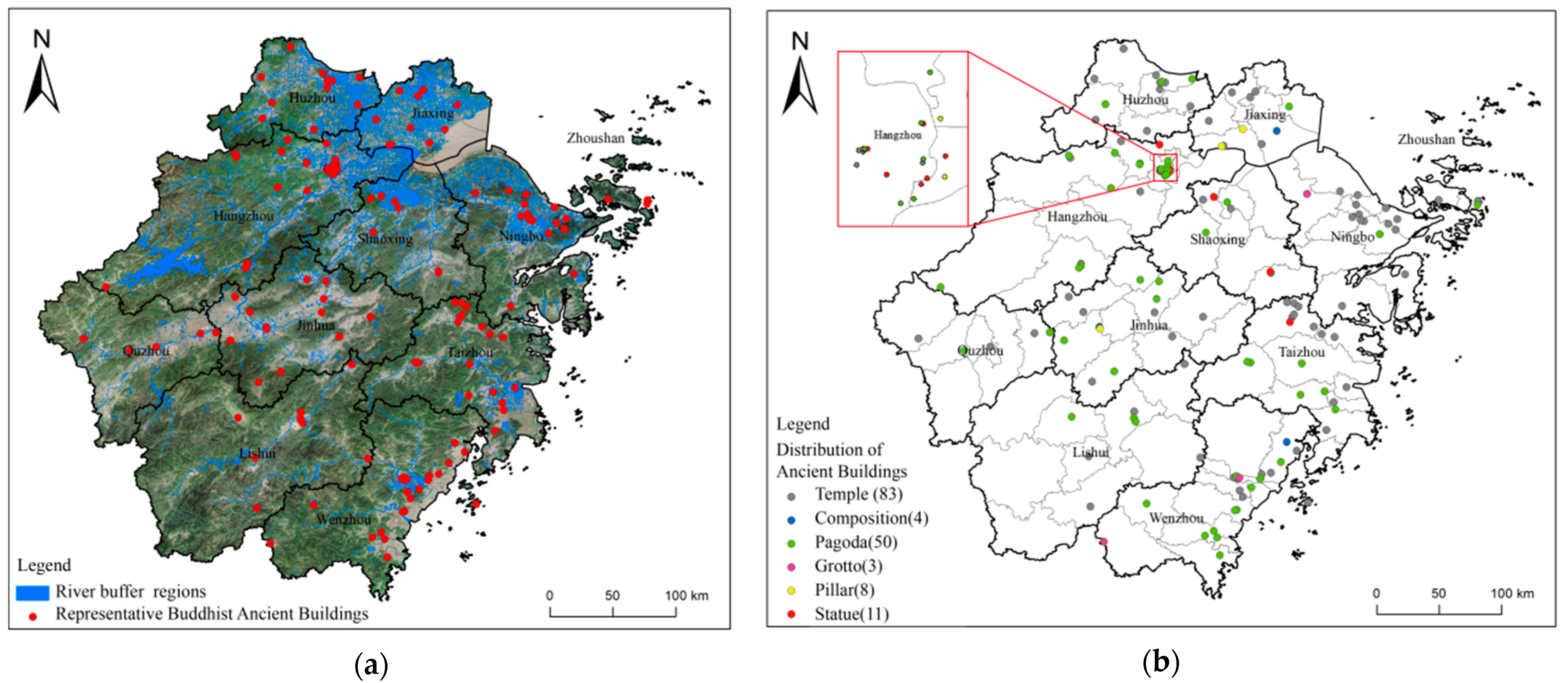
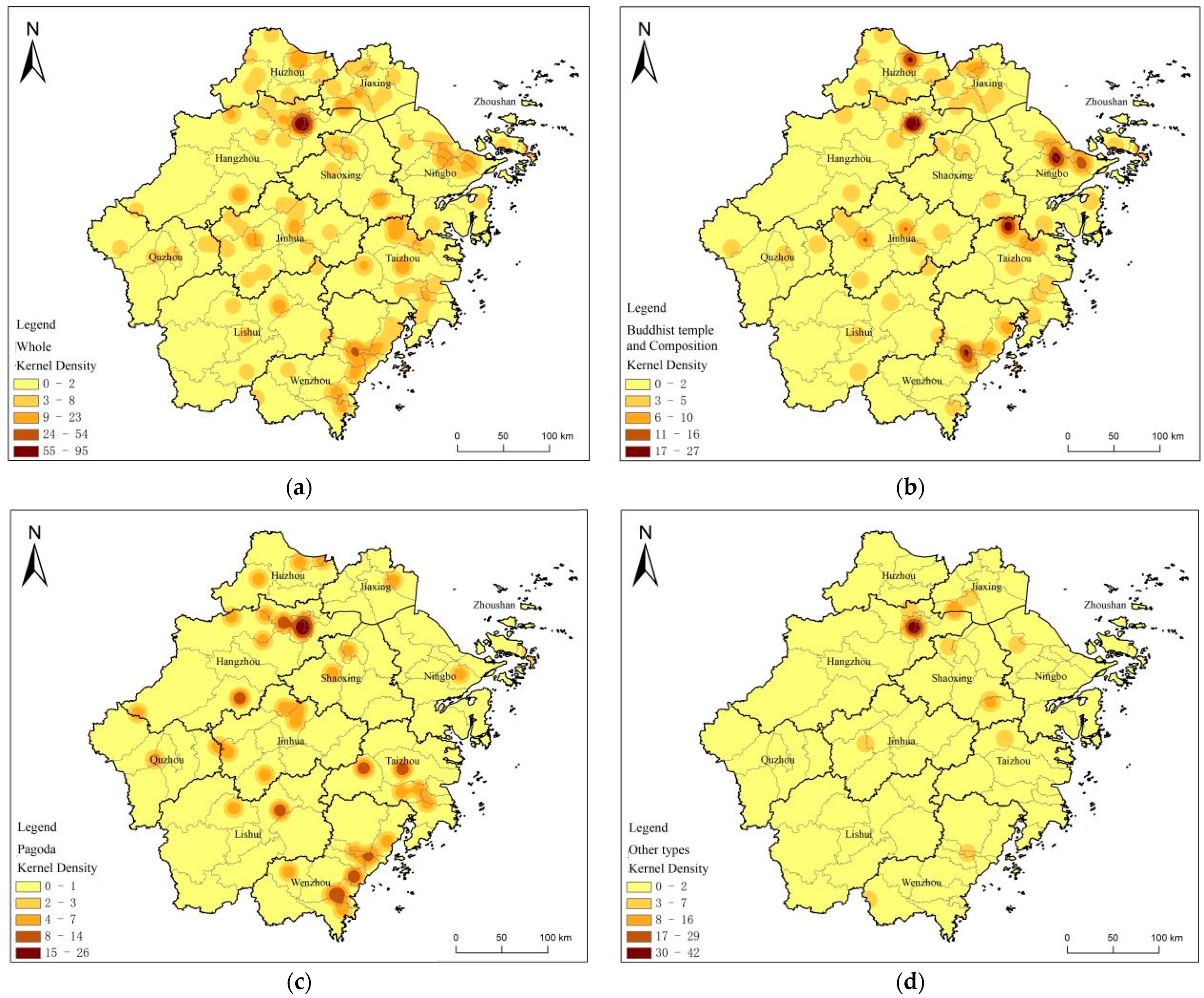
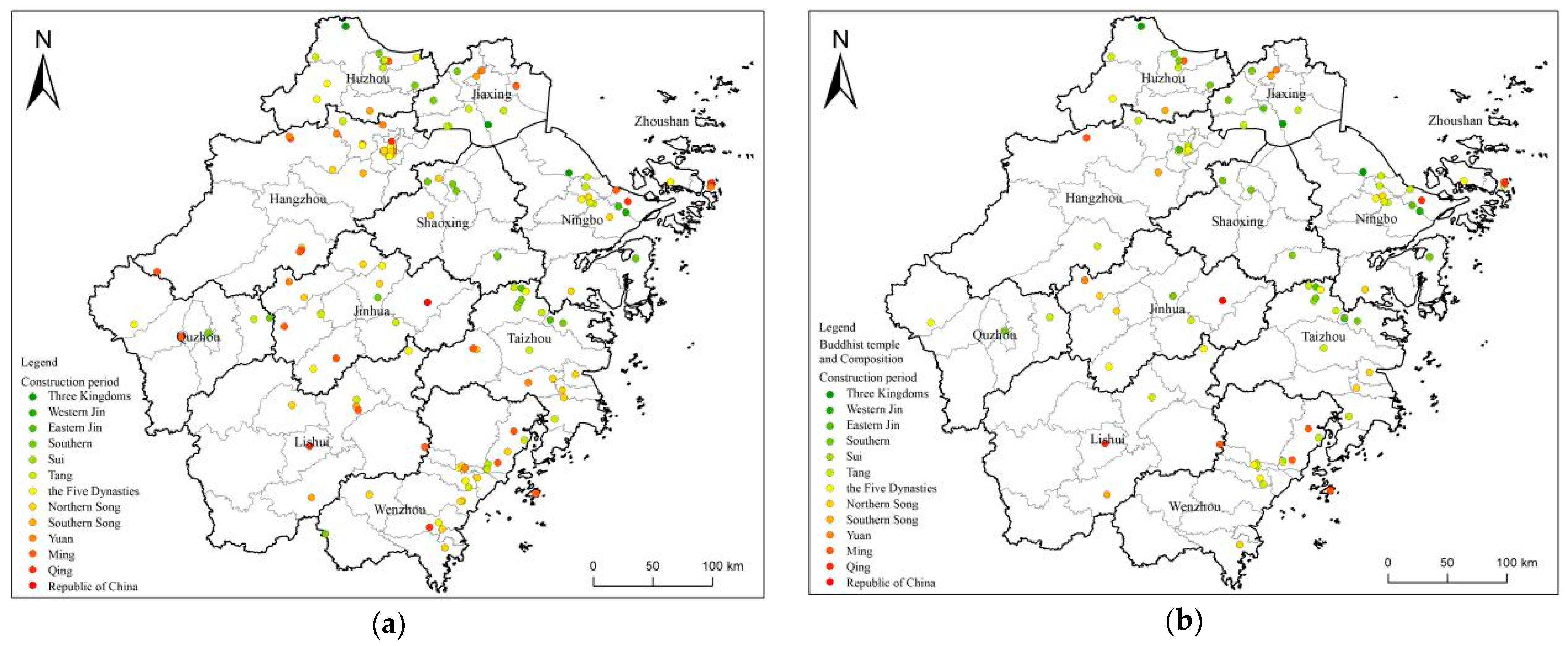

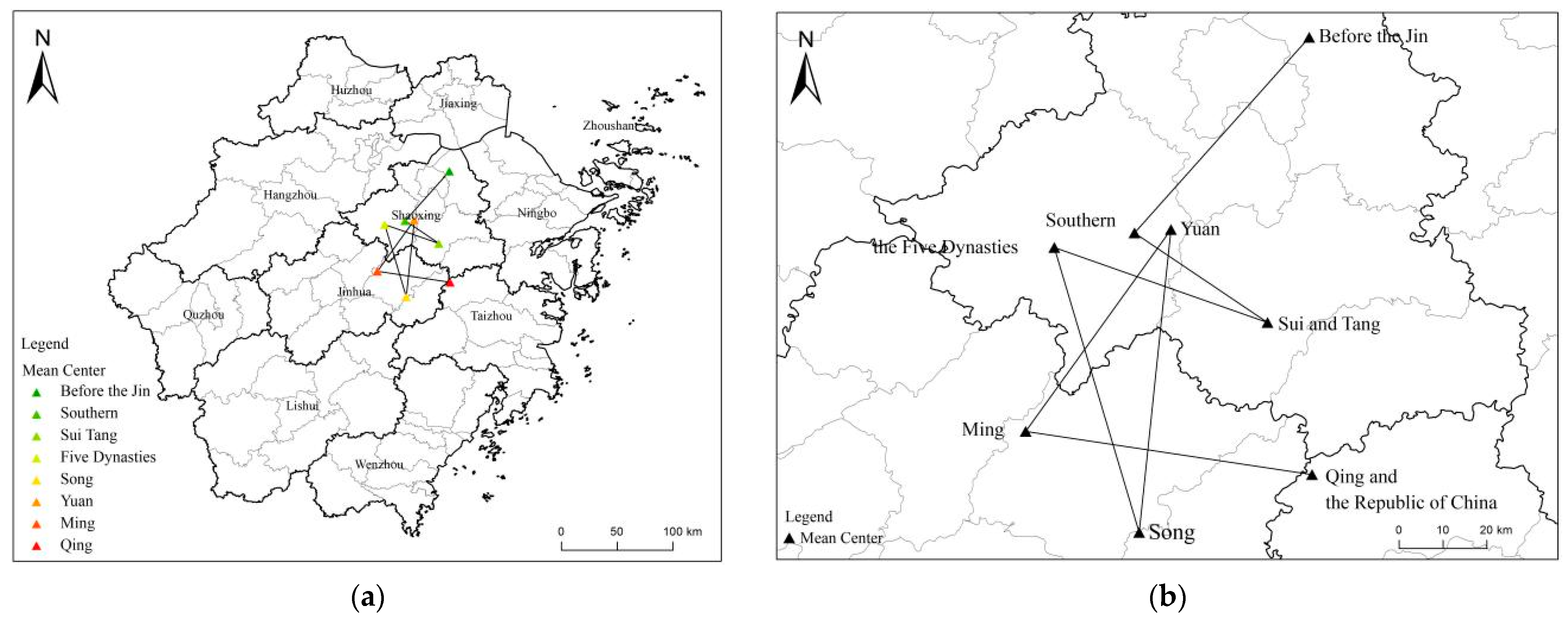

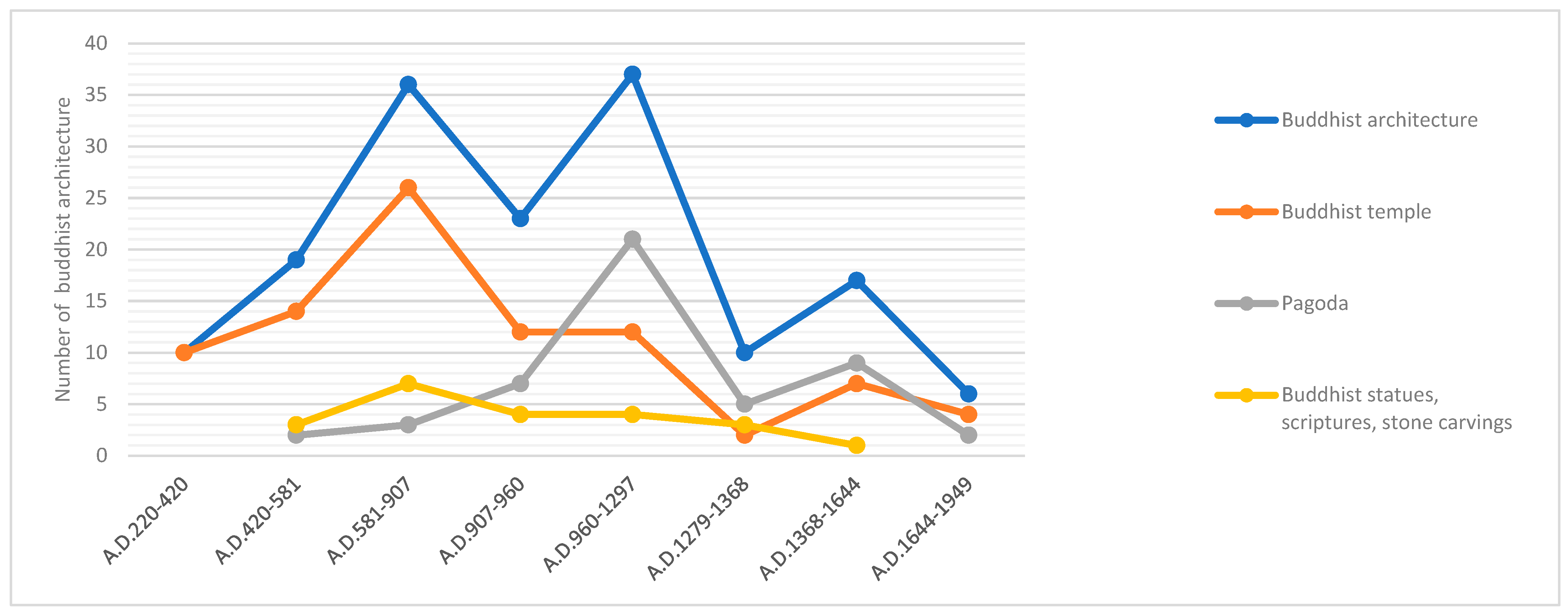
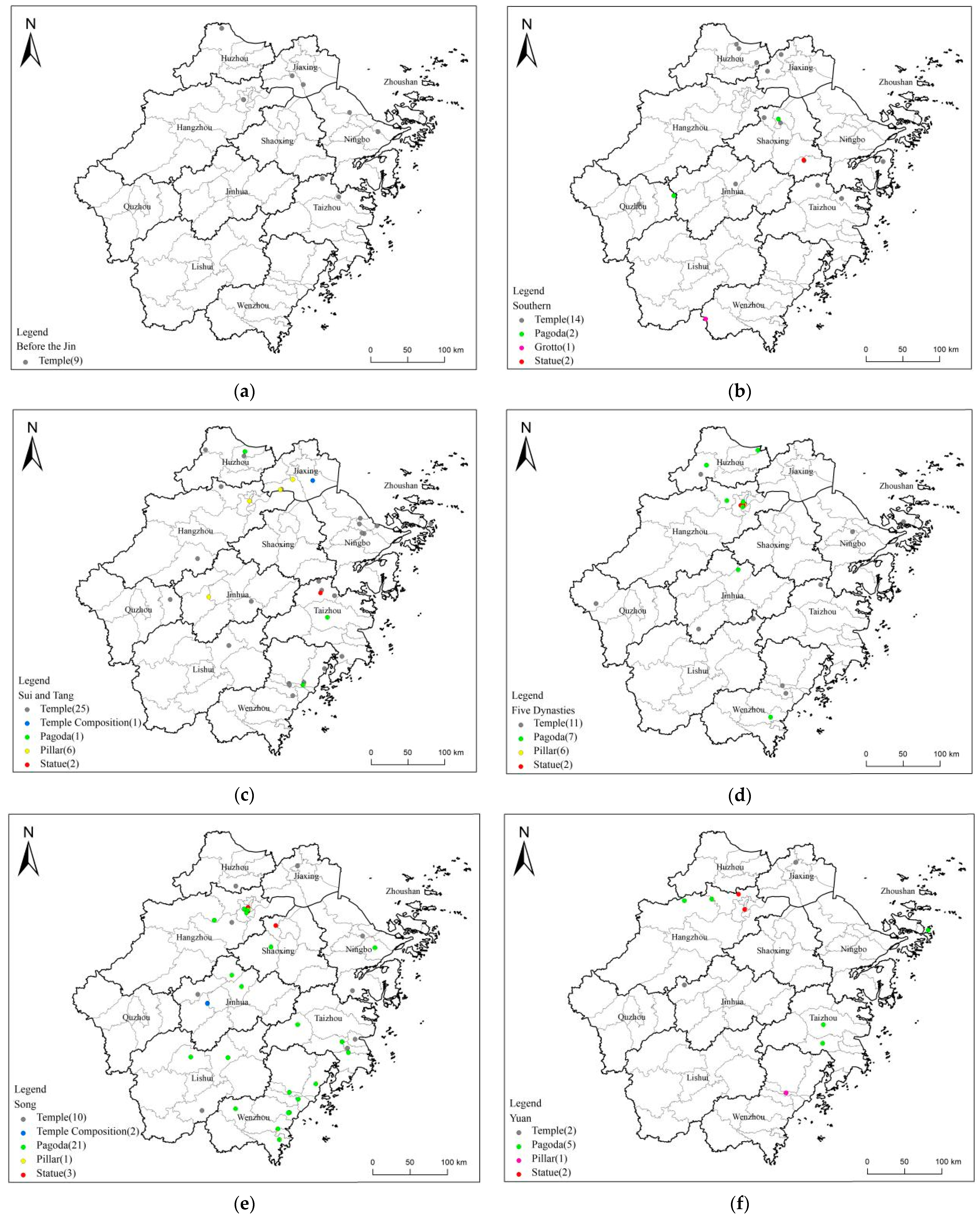
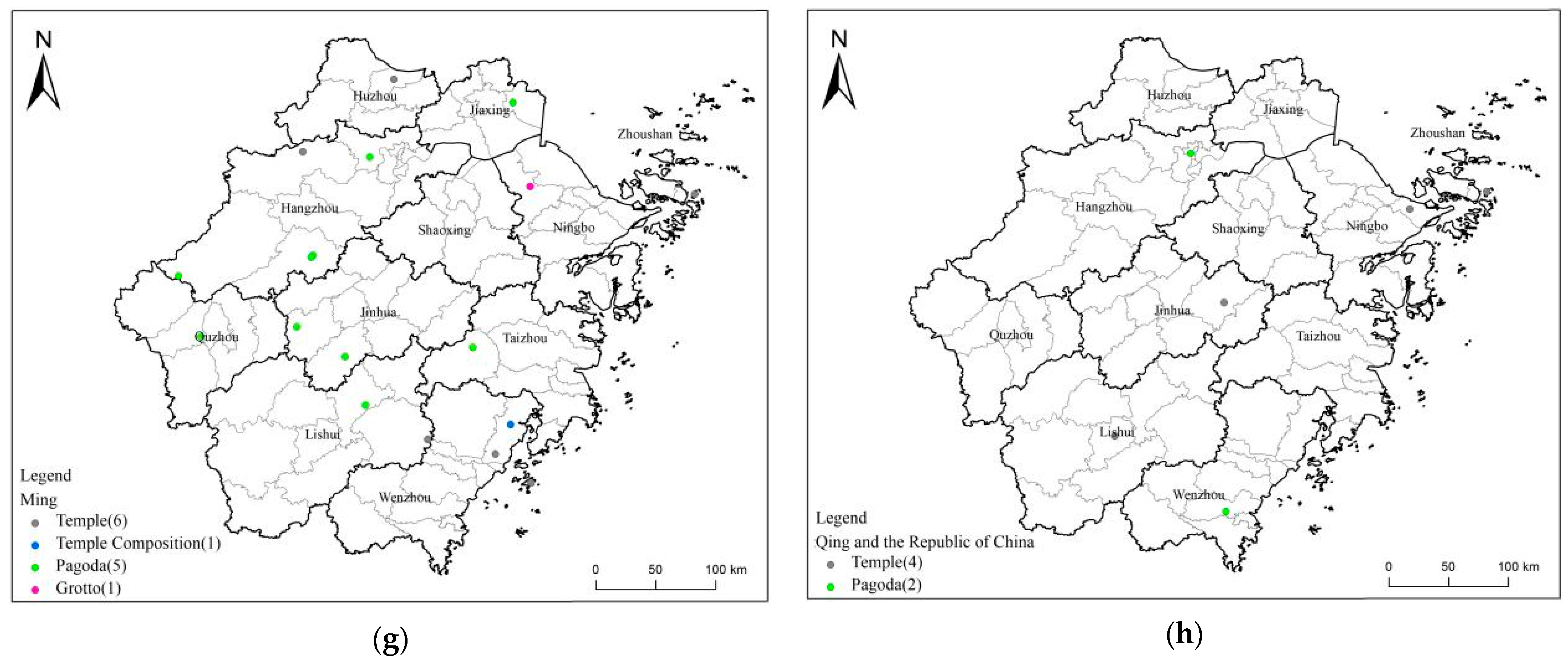



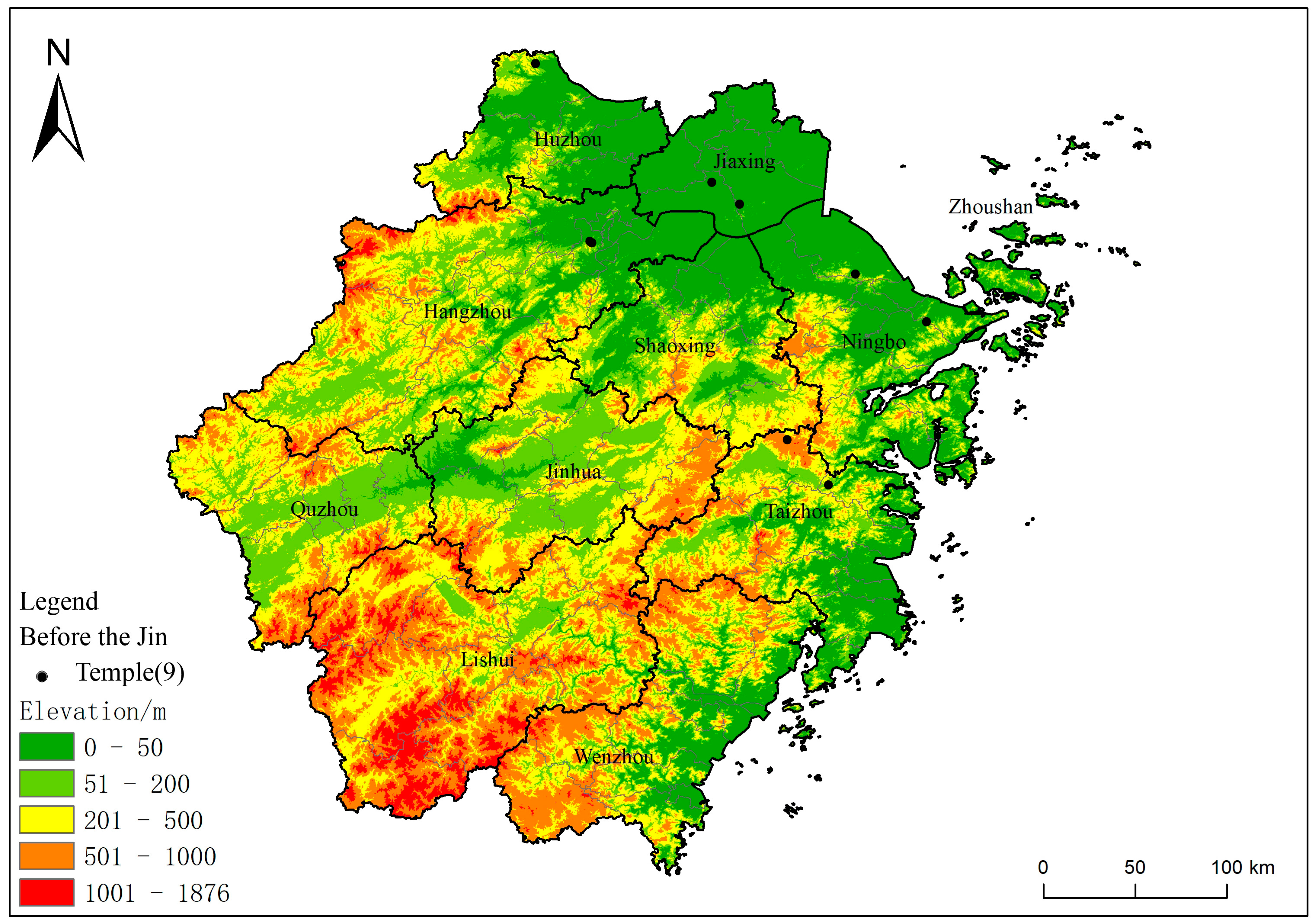
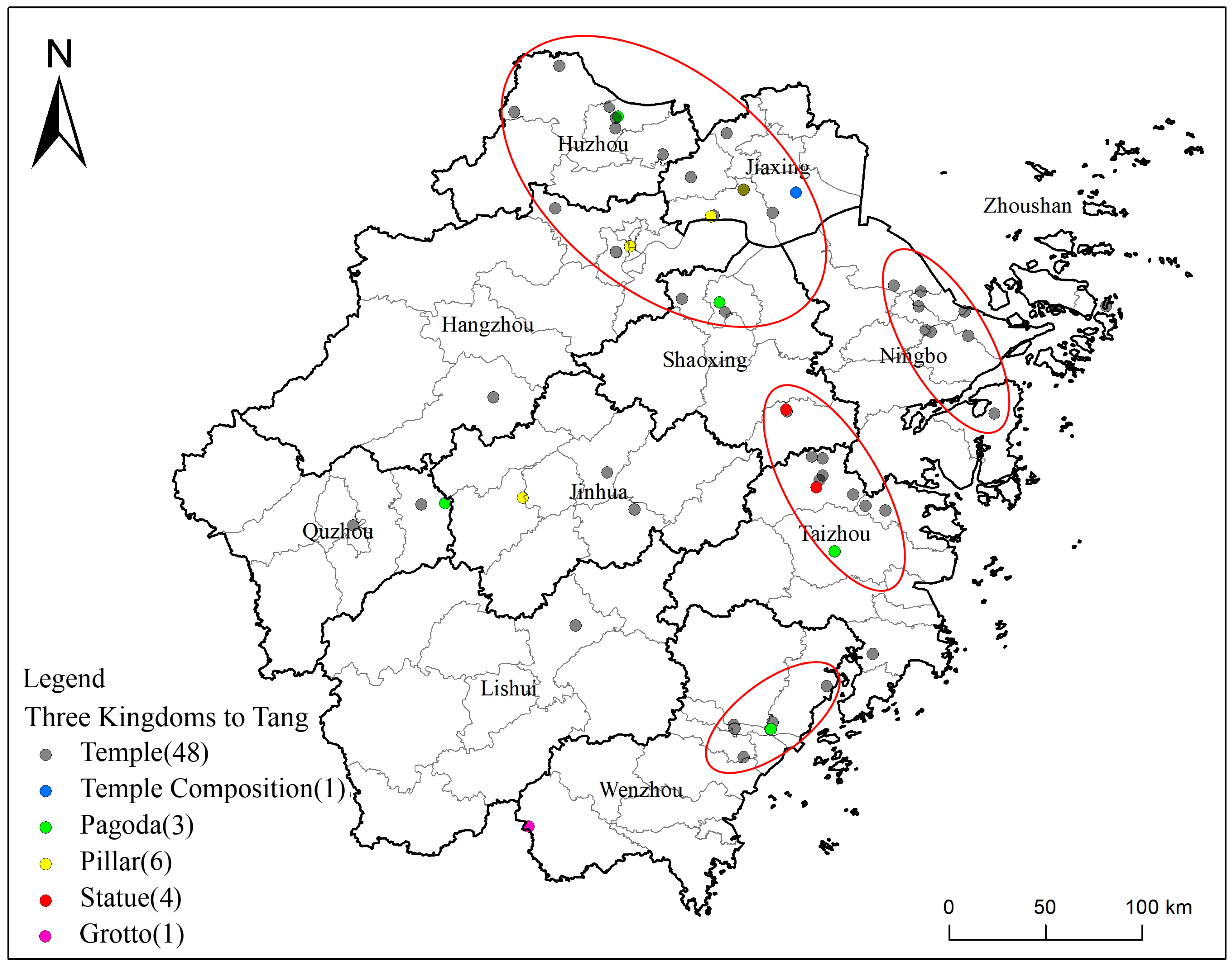
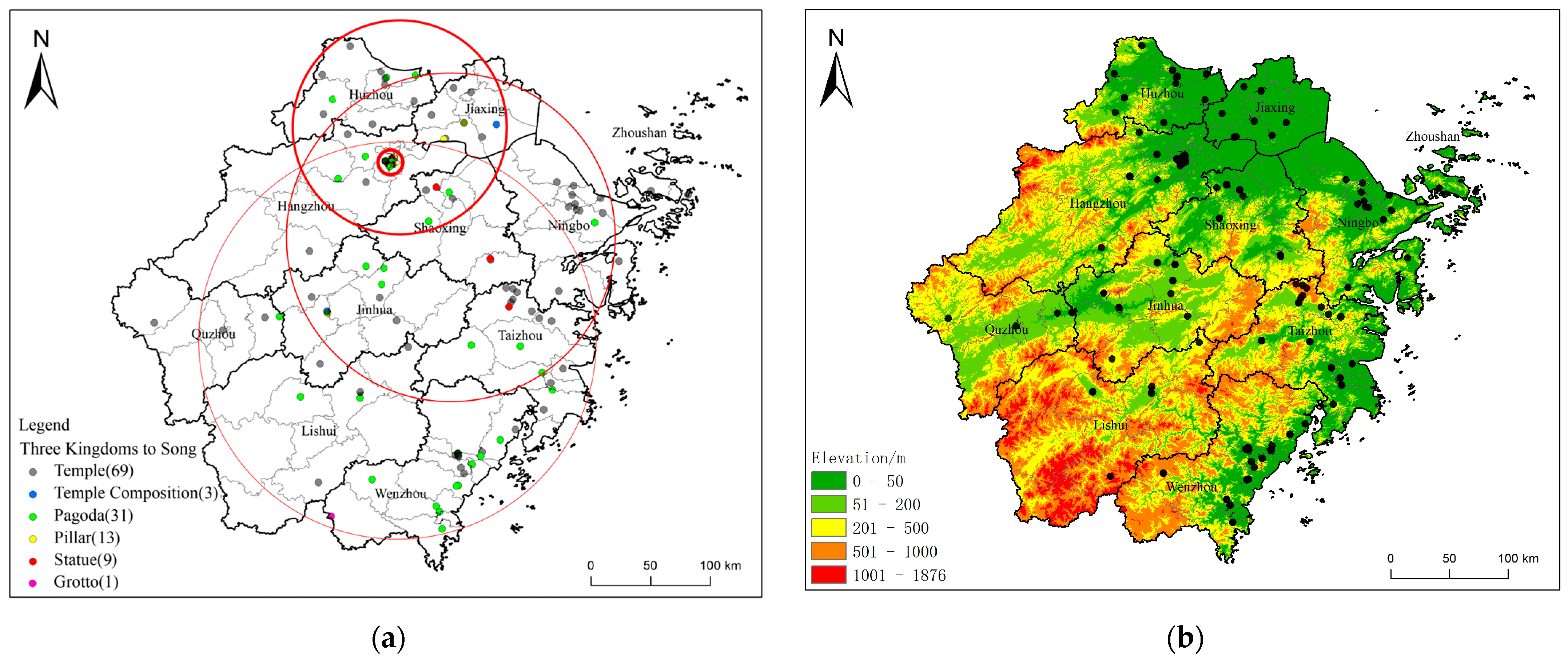
| City | Buddhist Temple | Constituent Structure | Pagoda | Pillar | Grotto | Statue | Total | Proportion |
|---|---|---|---|---|---|---|---|---|
| Hangzhou | 10 | —— | 14 | 3 | —— | 7 | 34 | 0.214 |
| Huzhou | 9 | —— | 3 | —— | —— | —— | 12 | 0.013 |
| Jiaxing | 7 | 1 | 1 | 4 | —— | —— | 13 | 0.082 |
| Jinhua | 8 | 1 | 5 | 1 | —— | —— | 15 | 0.094 |
| Lishui | 5 | —— | 3 | —— | —— | —— | 8 | 0.050 |
| Ningbo | 13 | —— | 1 | —— | 1 | —— | 15 | 0.094 |
| Quzhou | 3 | —— | 2 | —— | —— | —— | 5 | 0.031 |
| Wenzhou | 9 | 2 | 11 | —— | 2 | —— | 24 | 0.151 |
| Zhoushan | 4 | —— | 1 | —— | —— | —— | 5 | 0.031 |
| Shaoshing | 3 | —— | 2 | —— | —— | 3 | 8 | 0.050 |
| Taizhou | 12 | —— | 7 | —— | —— | 1 | 20 | 0.126 |
| Total | 83 | 4 | 50 | 8 | 3 | 11 | 159 | —— |
| Proportion | 0.522 | 0.025 | 0.314 | 0.050 | 0.019 | 0.044 | —— | —— |
| Construction Period | A.D. | Total | Buddhist Temples | Pagodas | Pillars, Statues, and Grottos |
|---|---|---|---|---|---|
| Three Kingdoms | 220–280 | 3 | 3 | ||
| Jin | 265–420 | 7 | 7 | ||
| Southern Dynasties | 420–589 | 19 | 14 | 2 | 3 |
| Sui | 581–618 | 2 | 1 | 1 | |
| Tang | 618–907 | 34 | 25 | 3 | 6 |
| Five Dynasties | 907–979 | 23 | 12 | 7 | 4 |
| Song | 960–1279 | 37 | 12 | 21 | 4 |
| Yuan | 1271–1368 | 10 | 2 | 5 | 3 |
| Ming | 1368–1644 | 17 | 7 | 9 | 1 |
| Qing | 1636–1912 | 5 | 3 | 2 | |
| Republic of China | 1912–1949 | 1 | 1 |
| Period | Observed Mean Distance/km | Expected Mean Distance/km | ANN | Z-Score | p-Value | Distribution Pattern |
|---|---|---|---|---|---|---|
| Total | 0.083997 | 0.129530 | 0.648475 | −8.479797 | 0 | Clustered |
| 220−420 | 0.299889 | 0.245532 | 1.221386 | 1.270583 | 0.203877 | Random |
| 420−581 | 0.253448 | 0.294557 | 0.860440 | −1.163771 | 0.244517 | Random |
| 581−907 | 0.170996 | 0.228147 | 0.749499 | −2.875353 | 0.004036 | Clustered |
| 907−960 | 0.334629 | 0.298270 | 1.121900 | 1.068668 | 0.285219 | Random |
| 960−1297 | 0.188505 | 0.208793 | 0.902831 | −1.130726 | 0.258170 | Random |
| 1279−1368 | 0.577736 | 0.400912 | 1.441055 | 2.668231 | 0.007625 | Dispersed |
| 1368−1644 | 0.456014 | 0.341167 | 1.365942 | 2.970161 | 0.002976 | Dispersed |
| 1644−1949 | 0.922661 | 0.505845 | 1.824001 | 3.861304 | 0.000113 | Dispersed |
| Altitude/m | 0–50 | 50–200 | 200–500 | 500–1000 | >1000 |
| Terrain type | Plain | Plain | Hills | Low mountain | Medium mountains |
| Buddhist architecture | 78 | 57 | 15 | 7 | 2 |
| Proportion | 0.49056604 | 0.35849057 | 0.09433962 | 0.04402516 | 0.03389831 |
| Buffer Range/km | 0–1 | 1–3 | 3–5 | 5–10 | >10 |
| Buddhist architecture | 50 | 28 | 20 | 17 | 44 |
| Proportion | 0.314465409 | 0.176100629 | 0.125786164 | 0.106918239 | 0.27672956 |
| Buffer Range/km | 0–1 | 1–2 | 2–4 | 4–8 | >8 |
| Buddhist architecture | 54 | 20 | 28 | 41 | 16 |
| Proportion | 0.33962264 | 0.12578616 | 0.17610063 | 0.25786164 | 0.10062893 |
Disclaimer/Publisher’s Note: The statements, opinions and data contained in all publications are solely those of the individual author(s) and contributor(s) and not of MDPI and/or the editor(s). MDPI and/or the editor(s) disclaim responsibility for any injury to people or property resulting from any ideas, methods, instructions or products referred to in the content. |
© 2023 by the author. Licensee MDPI, Basel, Switzerland. This article is an open access article distributed under the terms and conditions of the Creative Commons Attribution (CC BY) license (https://creativecommons.org/licenses/by/4.0/).
Share and Cite
Ju, F. Gathering Southward under Secularization and Syncretism: Study of the Spatial-Temporal Distribution and Influencing Factors of Chinese Historical Buddhist Architecture in Zhejiang. Religions 2023, 14, 1398. https://doi.org/10.3390/rel14111398
Ju F. Gathering Southward under Secularization and Syncretism: Study of the Spatial-Temporal Distribution and Influencing Factors of Chinese Historical Buddhist Architecture in Zhejiang. Religions. 2023; 14(11):1398. https://doi.org/10.3390/rel14111398
Chicago/Turabian StyleJu, Fei. 2023. "Gathering Southward under Secularization and Syncretism: Study of the Spatial-Temporal Distribution and Influencing Factors of Chinese Historical Buddhist Architecture in Zhejiang" Religions 14, no. 11: 1398. https://doi.org/10.3390/rel14111398
APA StyleJu, F. (2023). Gathering Southward under Secularization and Syncretism: Study of the Spatial-Temporal Distribution and Influencing Factors of Chinese Historical Buddhist Architecture in Zhejiang. Religions, 14(11), 1398. https://doi.org/10.3390/rel14111398






